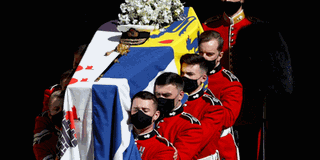Prince Philip funeral defines privacy of Queen, Royal Family

The coffin of Britain's Prince Philip, Duke of Edinburgh is laid onto a modified Land Rover Defender in the quadrangle ahead of the ceremonial funeral procession to St George's Chapel in Windsor Castle in Windsor, west of London, on April 17, 2021. Philip, who was married to Queen Elizabeth II for 73 years, died on April 9 aged 99 just weeks after a month-long stay in hospital for treatment to a heart condition and an infection. PHOTO/AFP
What you need to know:
- Prince Philip died on April 9, aged 99. His coffin was carried the short distance to St George’s Chapel on a modified Land Rover, which the duke himself helped to design.
Queen Elizabeth II on Saturday bid farewell to her late husband, Prince Philip, at a royal funeral like no other, restricted by coronavirus rules but reflecting his long life of military and public service.
This was nothing like the grand funeral that had long been planned. In normal times there would have been hundreds of guests from around the world joining the Queen and the Royal Family in mourning the Duke of Edinburgh. But many who knew him made the same observation: that the pared down nature of it was more in keeping with his character.
One aspect of this extraordinary event was unchanged, however, for this was a family that knows the eyes of the world will intrude on their private joys and private sorrows alike.
From the crenellated rooftop of the Round Tower, which dominates the distinctive Windsor sky line, I watched, as silence descended on the Quadrangle beneath the private royal apartments.
It is where the Duke of Edinburgh had died and where the Queen has been in residence throughout this period of mourning. To the left sits the monarch’s private chapel, where, in that quiet space, the duke’s coffin had lain for a week.
At just before 14:40, the bearer party, eight officers of the Grenadier Guards, brought his coffin out of the private chapel into the sun: out of its private domain and into the public. It was topped by a wreath of white flowers, his naval cap, and the ceremonial sword given to him by his father-in-law George VI on his marriage to the then-Princess Elizabeth.
This was the moment when the private sorrow of a family mourning their loss in their own home became wrapped - by the imperatives of royal duty - into the very public solemnity of regal ceremony and national commemoration.
There were echoes of modern continuities, too. The duke’s grandsons, princes William and Harry, walked behind his coffin just as they had walked, as children, behind the coffin of their mother 24 years ago.
As the Queen sat alone in St George’s Chapel just feet from the coffin of her husband, she did so in the public gaze, a gaze that has followed her throughout her long life and was there again, even at this moment of intense private anguish.

Members of the Royal Family walk behind the duke’s coffin during the funeral at Windsor Castle yesterday. PHOTO/COURTESY
The duke’s direction of his own funeral could be seen in the details. The modified Land Rover that carried this most travelled of men on his last journey was made to his own design. Much of the music had been chosen by him. And the prince who had, in life, frequently expressed exasperation with long sermons, had specified before he died: no sermon, no eulogy.
There was something poignant about the unadorned nature of the ceremony. At a grand state occasion with 800 guests, the intimacy of the family at the heart of it can be lost. Not today. The family sat in socially distanced household bubbles, in facemasks, just as countless families across the country have.
And as they watched the coffin being lowered into the Royal Vault, the absence of state pageantry made it easier to see the human beings behind the regal titles - to see the family. For that, and that alone, was what was there - a family, familiar to us all, alone and grieving.
Background
Prince Philip died on April 9, aged 99. His coffin was carried the short distance to St George’s Chapel on a modified Land Rover, which the duke himself helped to design. The procession was headed by the Band of the Grenadier Guards, the Major General’s party, and military service chiefs.




